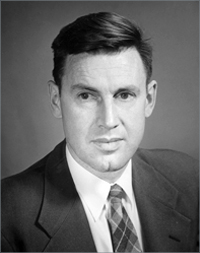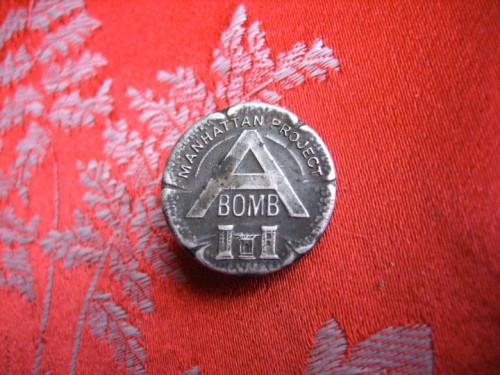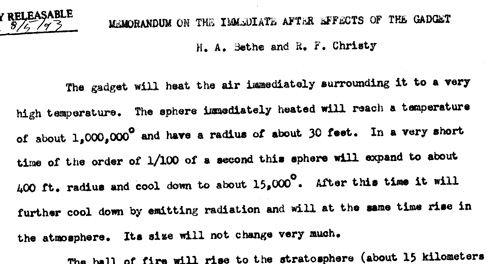
Robert Christy, ca. 1959. Via the AIP Emilio Segrè Visual Archives.
Robert F. Christy, one of the last remaining “big names” on the Manhattan Project, has died, at the age of 96.
I met Christy at his office in Pasadena in 2007, while I was doing some research at the Caltech Archives. He was extremely charitable with his time; it was clear even then that his health wasn’t great.
We talked a little bit about the origins of the famous “Christy Gadget” — the solid-core design of the Trinity and Nagasaki implosion bombs. Christy always got the credit for that, to the point of it being dubbed his Gadget, and the solid-core models being referred to as “Christies” for some time afterwards. To me, he professed to being a little confused as to why he, of all people, got his name attached to it.
The solid-core concept was originally proposed by Edward Teller, whose experience working with George Gamow on the iron core of the Earth gave him the somewhat unintuitive knowledge that even very dense materials can be compressed to even higher densities under many megabars of uniform force. Christy, for his part, was the guy who took it from the “Teller’s interesting but potentially wrong idea” phase to the “so will it actually work?” phase. And he did a good job of that — everyone was convinced that a solid core bomb would be both plausible and easier than the alternatives (such as a hollow core bomb).
I asked Christy what he thought about having his name associated with a design for a nuclear bomb — one of the only two that was actually dropped on cities. He said he didn’t really mind.
We also talked a bit about Los Alamos patenting procedures; this was still in the very early days of my work on the patenting of the atomic bomb. Christy confirmed to me that indeed, he had had to sign off his patent rights to the bomb almost immediately after arrival. I only much more recently learned that there is still a secret patent application for the bomb in Christy’s name. (There are about a dozen of these still-secret bomb patents.) The DOE was willing to let me know its predictably unrevealing and dull name: Robert Christy and Rudolph Peierls, “Method and apparatus for explosively releasing nuclear energy,” filed August 27, 1946. Still secret after all these years. (I now regret having not gotten in touch with Christy again and asking if he even knew about it — I suspect not.)
The only other remarkable thing from our conversation is that he asked me if I could find declassified copies of reports he had written from that time period, because he had never been able to get ahold of them himself! I sent him half a dozen of them, including this one that might interest my readers: “Memorandum on the Immediate After Effects of the Gadget,” by Hans Bethe and Robert F. Christy, dated December 1944. (My original source for this was Los Alamos’ history website, but see below for a note on that.)
In their report, Bethe and Christy attempt to describe, in quantitative as well as qualitative terms, what the effects of an exploding atomic bomb would be, apparently with the question of in mind of how a pilot would be able to drop this from a plane and also survive it. It is written quite readably, for something that must have been based on extensive calculations. Notably, it dismisses the hazards of fallout:
The radioactive materials are expected to be near the center of the ball of fire and rise with that ball of fire to the stratosphere. Presumably the ball of fire will rise to very considerable height (100 kilometers or more) before its rise is stopped by either diffusion or cooling. If the radioactive material ever comes down again it will certainly be spread out over a radius of at least 100 kilometers and probably very more and will, therefore, be completely harmless.
There some hedging there (“probably,” “if”), but it still is a highly idealized treatment of a very serious health question — lots of things affect the deposition of fallout (weather being an important one of them), and I do wonder if “completely harmless” was perhaps a bit too strong of a phrase. (A post on this specific question is slated for a few weeks from now.)
One last little thing on Christy specifically: in 1994, he did an Oral History interview at Caltech, the transcript of which is online. One thing I didn’t know is that Christy and his family briefly shared a house with Edward Teller and his family in Chicago right after the war. The many connections of Christy with Teller are particularly interesting in that Christy cut off all relations with Teller after the Oppenheimer security hearing. His was the hand shake that Teller was famously denied at Los Alamos, which signaled to Teller that his life had irrevocably changed on account of his involvement with the Oppenheimer affair. In the Oral History, Christy details the incident:
Well, my feelings were very strong. I told you earlier that in some sense I viewed Oppenheimer as a god. He was on a pedestal, and I looked up to him. And I was sure that he was not a treasonable person. I knew he had leftist contacts; that was well known to everyone. But I felt that it was just the wrong thing to do, for an honorable physicist to testify against Oppenheimer. It just wasn’t right. And I was very upset by it. I still am. I felt, therefore, that it as really improper, it was wrong. …
I ran into [Teller] not long afterward. We were both at Los Alamos—this was in the summertime. I remember that the Fuller Lodge was where they had an eating establishment. It was a fine, beautiful old log building. And there I was, eating. And I happened to see Edward Teller. I believe he approached me with his hand out to shake my hand. And I very deliberately refused to shake his hand. …
[I]t was a very deliberate action on my part—impulse, of course, because I didn’t have time to plan this. And it was recognized by everyone else for what it was—that I refused to have a direct association with him. I think he was somewhat hurt. … I’ve seen him from time to time [since then]. Our relationship has remained cool.
The connection between Teller and Christy on the solid-core bomb, and the fact that they shared a house together after the war, makes all of this even more poignant. Rest in Peace, Robert F. Christy.

One of the silver Manhattan Project pins given to individuals who worked on the Manhattan Project for over a year. From my personal collection.
Every time one of these major Manhattan Project scientists dies, I wonder, how many of them are still left? Looking at an intersection of the Wikipedia categories “Manhattan Project people” and “Living people,” I came up with this paltry list of eleven names:
Jack Aeby
Harold Agnew
Philip J. Dolan
Anthony French
Roy J. Glauber
David Greenglass
Dieter Gruen
William Perl
Ed Westcott
Robin M. Williams
Hubert Yockey
That’s not a big list. I bolded the ones I recognized immediately.1 (Undoubtedly there are lots of other people who worked on the Manhattan Project, even in a scientific context, who are still alive — but they aren’t really known for it, and they weren’t really “major figures.”) Only Agnew was something of a big wig at Los Alamos, and even then, he was a pretty young (early 20s) guy. Greenglass was of course notorious and interesting for that reason. Aeby and Westcott’s work is well known even if their names are not (though Westcott is a much-beloved figure for Oak Ridgers). French’s Los Alamos experience is interesting (he worked on the cross-section of deuterium reactions, if I remember correctly), but not very well known.
We are on the precipice of an age where no one alive will have worked on the Manhattan Project. It’s very close. I’ve thought quite a lot about this, and talked about it with other nuclear historians. Is this a good or a bad thing, from an historical point of view? I’m mixed on it — immediacy can be useful for reconstructing the past, as lots of great historians before me have shown. But getting beyond the immediate can be useful, too, for taking a more detached look at things. Whether that detachment will lead to deeper insight, or just easier dismissal of the past’s fears and hopes, is something we’ll have to see.
In the process of writing this post up, I found, in a bitter irony, that Los Alamos seems to have — in the last week or two — completely taken down their once-excellent online history exhibit (including all of those staff photographs) and replaced it with an awful piece of corporate copy that rambles meaninglessly about their commitment to “innovation.” All of those cool photographs, nice write-ups, and online documents? Gone. All that remains is a desiccated timeline and a Flickr feed of many of the same images that used to be in the exhibit, sans context. Thanks, Los Alamos National Security, LLC! Way to prove your critics wrong about your corporate sensibilities. Maybe I’m jumping the gun, and they’ll replace it with something even better — or eventually restore it — but we’ll have to see. At a time when the living legacies of the Manhattan Project are disappearing, it’s sad to see that the lab has made reading about its own past a more difficult endeavor.
- Aeby is known primarily as the guy who took that one color photograph of the Trinity test, which graces the cover of The Making of the Atomic Bomb (which I see just came out in a 25th anniversary edition and no longer features that photograph as prominently as in the past). Agnew was a major figure, present at the bombing of Hiroshima and later a director of Los Alamos. Dolan is mostly recognizable to me (and most others) as half of the famous Glasstone and Dolan duo that edited the Effects of Nuclear Weapons books. Glauber won the Nobel Prize in Physics in 2005 and is quite scientifically distinguished (and a known presence at Harvard). Greenglass was the brother-in-law of Julius Rosenberg, and a confessed spy. French was part of the British delegation to Los Alamos, and I’ve talked with him at MIT; he’s written a number of important physics textbooks, as well. (Fun fact: he bought Klaus Fuchs’ car after the war ended — the same one that Fuchs smuggled his secrets out of in the trunk — and drove it back to Cambridge. He then re-sold it to someone else, who had the unfortunate fate of having it searched and dismantled by the FBI years later.) Westcott was the official photographer at Oak Ridge.
Of the others: Gruen worked on isotope separation and later became a senior scientist at Argonne National Laboratory; a name not known to me, but probably known to others. Perl was apparently another minor Rosenberg ring spy (and it’s not clear to me that he’s actually known to be still alive — there’s very little reference to him other than his conviction in the early 1950s). Williams seems to have later gone on to a state career in New Zealand, but it’s not quite clear to me what he did with the Manhattan Project; unlikely a major figure. Yockey is an information theorist who was a student of Oppenheimer’s. [↩]




The loss of the LANL web site was a real bummer.
They have told me, over the phone, that they might put it back up if people like you and me let them know we miss it. I hope they do. It was waaay better than anything Livermore had ever put up. (Hint, hint.) I have copies of almost all (~140) of the PDF documents they put on the old site, though, for what that’s worth.
Alex,
Very sorry to see another Manhattan Project veteran pass. You may already be aware of it but the late Wolfgang K.H. “Pief” Panofsky organized an event to note the 60th anniversary of the Trinity test at the National Academy of Sciences in 2005. Documents, audio files and a transcript from the event are archived here: http://sites.nationalacademies.org/PGA/cisac/PGA_049740 and http://sites.nationalacademies.org/PGA/cisac/PGA_049739 Dr. Christy and 10 other scientists detail their experiences on the day of the test and during the Manhattan project. Many of the talks are rather remarkable, especially Dr. Donald Hornig’s account of “babysitting the live bomb” in the tower during the lighting storm the night before the test, I recall that his account was broadcast on NPR after the 2005 event – BJR
Thank you for passing that on!
Alex,
We’ve restored the history site. We’re hoping to upgrade it for the Lab’s 70th anniversary commemoration next year, but will stay in the meantime. http://www.lanl.gov/history/
We’re proud of our history and look forward to the next 70 years. Sorry for any inconvenience.
Regards,
Fred deSousa
Los Alamos National Laboratory
Three cheers!
[…] Robert Christy usually gets the credit for the solid core. It was Teller’s initial idea, but it was Christy who proved it would work. [↩] […]
[…] last generation of people who worked on the first atomic bombs is passing away. The bomb still exists. We should be doing more to preserve these sites, even if they make us […]